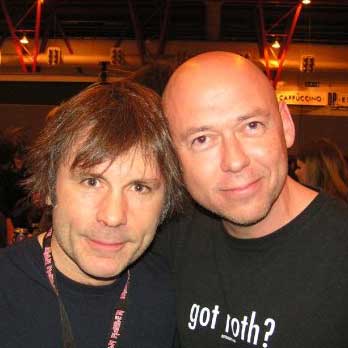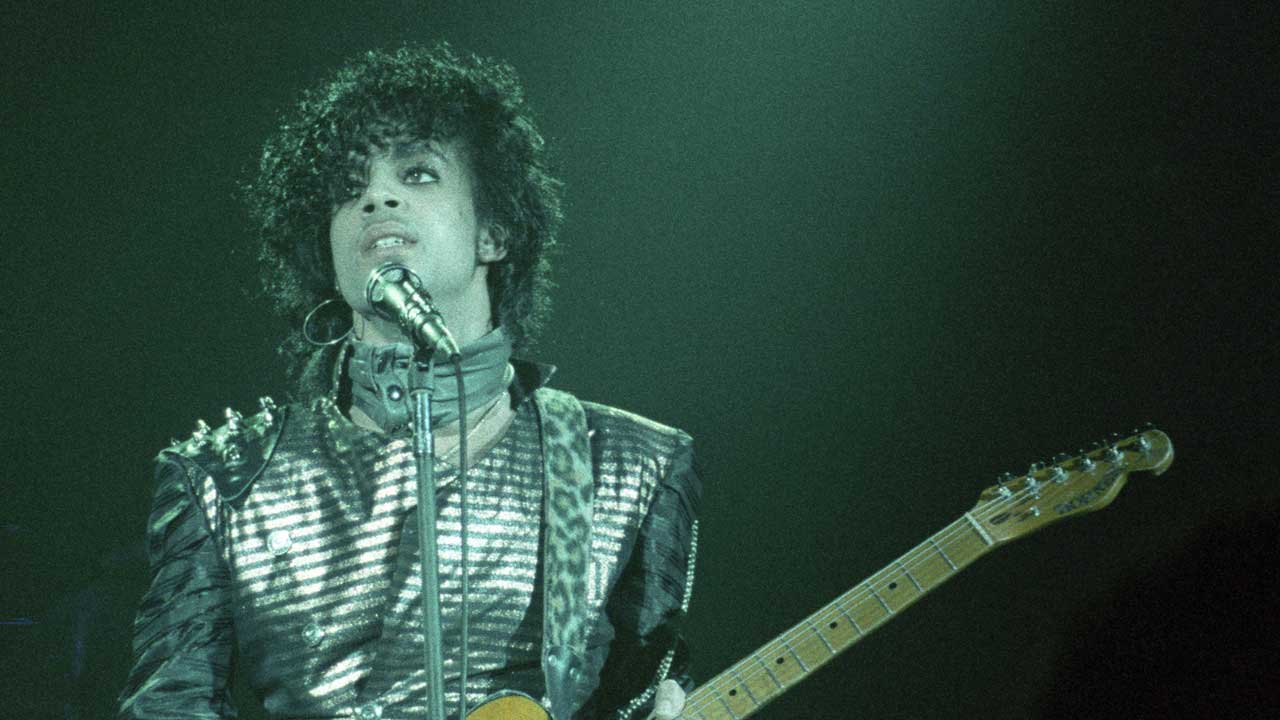"A guy's just died and here we are making this euphoric, celebratory music. It seemed a bit weird": How Def Leppard overcame tragedy and made Adrenalize
Reeling from the death of guitarist Steve Clark, Def Leppard were determined to keep the party going. The result was Adrenalize – their last great blockbuster album
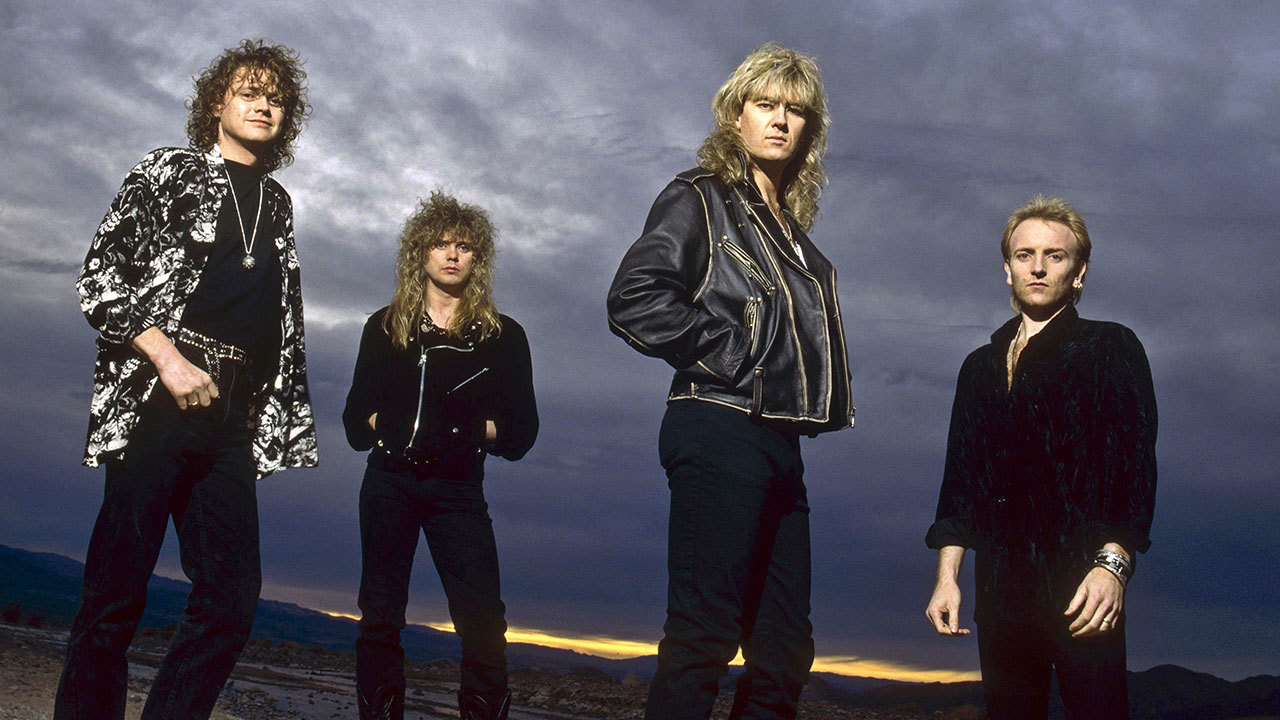
It began with a question: ‘Do you wanna get rocked?’ The answer came back loud and clear when Def Leppard’s Adrenalize hit No.1 globally in 1992. For one of rock’s biggest bands, it seemed like business as usual. In reality it was anything but.
If ever a band had to dig deep to make an album, it was Def Leppard with Adrenalize. They had done so before, in creating their 1987 album Hysteria after drummer Rick Allen lost his left arm in a car crash on New Year’s Eve 1984, and had to reinvent the way he played, using a specially developed electronic kit. But in the making of Adrenalize the band suffered their darkest day – the death of guitarist Steve Clark on January 8, 1991, following a long struggle with alcoholism.
As Leppard singer Joe Elliott says now, looking back at that difficult time: “It was tough. Emotionally, so draining. But we didn’t want to split up the band like Led Zeppelin did after John Bonham died. We were tying to keep ourselves from drowning.”
Def Leppard made Adrenalize under intense pressure, both internal and external. In the absence of Steve Clark, it was left to Phil Collen, the band’s other guitarist, to replicate their signature two-guitar sound. They also had to find a new producer at a time when their mentor Mutt Lange was busy working with another client, Bryan Adams. In addition, there was the burden of expectation to match an album that had sold fifteen million copies worldwide. “How the hell do you follow Hysteria?” says Elliott.
What they achieved with Adrenalize was, as with Hysteria, a triumph over adversity. Def Leppard was always, in Elliott’s words, “an escapism band, for us and for everybody else”. And never more so than on Adrenalize. It included a memorial to Steve Clark: a powerful, sombre track titled White Lightning. But as they made this album, one comment from Mutt Lange resonated deeply within the band. While acknowledging the impact of Clark’s death, Lange told them: “People don’t want to hear Def Leppard doing Leonard Cohen.”
Elliott recalls: “A guy’s just died and here we are making this euphoric, celebratory music. It seemed a bit weird. But we made a point of remembering who we are, what we do and what we do well.” And it was the question ‘Do you wanna get rocked?’ – the opening line from would be the album’s opening track, Let’s Get Rocked – which set the tone. For all the sadness that surrounded the making of it, Adrenalize was a celebration of the life-affirming power of rock’n’roll.
In February 1992, one month before the release of Adrenalize, Joe Elliott ended up in tears when he spoke to me about the death of Clark and the band’s efforts to save him. In a room at the St James Club in Hollywood, he said solemnly: “We’d lost Steve a year before he died. We couldn’t do anything more for him.”
Sign up below to get the latest from Classic Rock, plus exclusive special offers, direct to your inbox!

It was in January 1978 that Steve Clark joined Def Leppard, five months after the band formed in Sheffield. At his audition, he played the end solo from Lynyrd Skynyrd’s Free Bird. It was so good that Elliott said, without hesitation: “He’s in.”
In the band’s early days they dreamed of emulating their heroes – Zeppelin, Lizzy, Queen. Those dreams had come true with Hysteria, and predecessor Pyromania, another multimillion seller. On stage, Clark was the classic guitar hero. Off stage, he was an introvert who became heavily dependent on alcohol. During the Hysteria tour, Clark got drunk only after shows or on days off. After that tour ended in 1988, his problem deepened. As Elliott explained: “Once we came off the road, Steve’s routine became just drinking.”
What the singer revealed about the last years of Clark’s life was harrowing. Between 1989 and 1990 he had six separate spells in rehab. For a long period he remained a functioning member of the band. During the early songwriting sessions for Adrenalize, in which Mutt Lange was also involved, Clark co-wrote six of the 10 songs that were included on the album.
It was when he was away from the band that Clark went off the rails. While on holiday in Minneapolis, he was found unconscious in a street, with an alcohol level in his blood higher than that which killed Led Zeppelin drummer John Bonham in 1980; double the level that can induce coma. Clark was admitted to a psychiatric ward in Minneapolis. Elliott visited him there, and recalled: “It was basically like a nut house. I was looking at Clarkie thinking: ‘What the fuck are you doing in here?’ He looked like a dead man.”
Later, in Dublin, Clark was present as the band began recording basic tracks for the album. He was also attending a rehab facility close by, where Elliott would sit with him during group therapy sessions. What he realised then was that Clark was in complete denial. “He thought he was fine,” he said. “He didn’t believe that he had a problem.”
There was a deeper realisation that for Elliott was heartbreaking: “Steve was the nicest guy in the world. But he was a very complex person. I’d known for years, but I didn’t know him at all. He had everything, yet he had nothing. You do your best to help. Towards the end it just got impossible. But you don’t think he’s actually going to die.”
In September 1990, the band delivered an ultimatum to Clark. “We gave him a totally unconditional, very informal six months’ leave of absence,” Elliott said. “He absolutely hadn’t been fired, we weren’t gonna look for somebody else.” Clark returned to London, where he had a new home in Chelsea. Elliott told him: “We’re going to carry on working on the album, and come February, come back and see how things are.”
In those last four months, Elliott and the other members of the band would call Clark from time to time. They also had mutual friends checking on him.
It was Cliff Burnstein, the band’s co-manager, who broke the news to Elliott on January 9, 1991.
“I wasn’t surprised,” he admitted to me. “I was upset, the way you’re upset when your ninety-nine-year-old granny dies. Steve’s dad said to me that he wouldn’t make his thirtieth birthday. He made it by six months. I cried my head off when Rick lost his arm. But when Steve died I didn’t.”
The coroner’s report, dated February 27, cited the cause of death as “respiratory failure” due to consumption of “an excess of alcohol mixed with anti-depressants and painkillers”.
What haunted Elliott was the call he made to Clark on the day before he died. “I got his answering machine,” he said. “That killed me for weeks. If I’d spoken to him, maybe it would have changed the next twenty-four hours…” Elliott might not have cried when Steve Clark died, but he did as he said that to me.
Clark was laid to rest at Wisewood Cemetery in Sheffield. Phil Collen didn’t attend the funeral. “I loved Steve dearly,” he says, “but I knew that a lot of people would show up at the funeral that weren’t around when he needed help. And to he honest, I actually felt worse when he was alive.” Collen was never asked to explain his decision.
“It’s a very private matter,” Elliott says. One image from the funeral has stuck in his mind ever since: “All I remember is being at the graveside, and watching Steve’s mum Beryl grieving so desperately.”
Def Leppard went back to work the very next day. As Elliott said in 1992: “We had to get on with our lives. We weren’t going to lose those songs, because they were too good, and Steve just wouldn’t have wanted us to quit anyway.” He adds now: “When Steve passed away we’d been working as a four-piece for seven or eight months anyway, in spirit and physically.”
Even so, Collen struggled. “There was a period when I just didn’t want to do it,” he says. “It felt really wrong doing it without Steve. Joe had to talk me off the ledge: ‘Come on, we wrote these songs with Steve…’ In the end I knew he was right.”
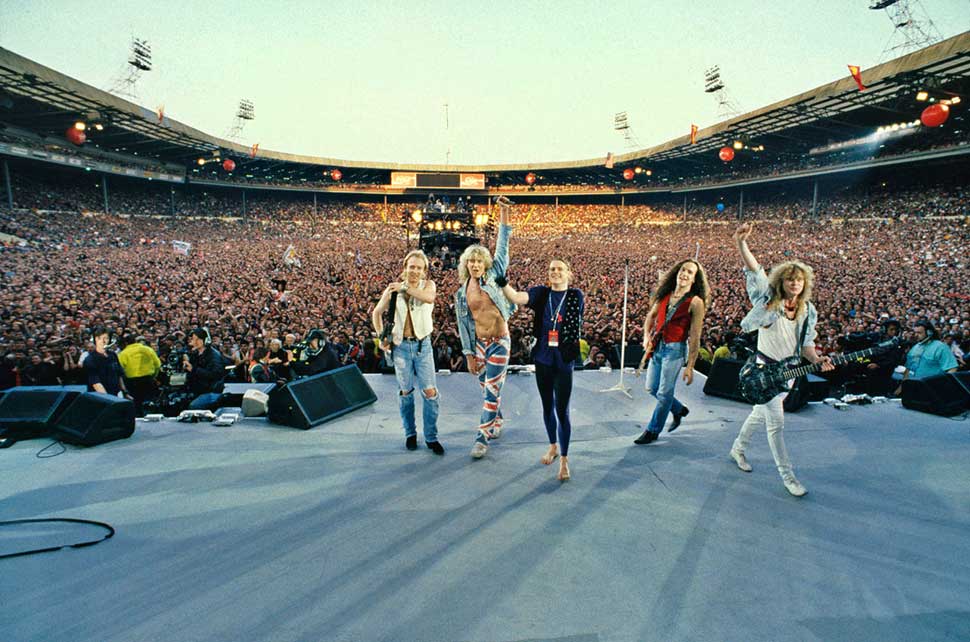
Def Leppard stuck together, just as they had after the trauma experienced by Rick Allen. “We had each other to lean on,” Elliott said. “That’s the great thing about a band.” They also had Mutt Lange to guide them, albeit in a more limited role than before.
Lange had done so much to shape the band’s sound that they had called him their “sixth member”. As with Pyromania and Hysteria, Lange had co-written the songs for Adrenalize. But as the band began recording, Lange was still working on Bryan Adams’s album Waking Up The Neighbours. So they turned instead to Lange’s right-hand man, Mike Shipley, who had mixed Hysteria and engineered Pyromania. “We figured that us co-producing with Mike would be the next best thing to Mutt,” Elliott said.
But Lange’s influence continued throughout the making of Adrenalize. “Mutt was on the phone every day, trying to rally the troops,” Elliott recalls. During breaks in Adams’s schedule, Lange wrote with Leppard and contributed backing vocals for Adrenalize – another feature that was integral to the band’s signature sound.
Phil Collen decided early on that he would play all the guitars on the album. He explains: “Why bring someone in who doesn’t get what we’re all about? I’d be teaching someone. The weird thing was that I had to learn Steve’s parts from the demos we’d laid down together on four-track. It was like listening to a ghost; he was in the room. I just wanted to do him justice, to make it sound as close as I could to how it was with Steve.”
The first stages of recording were at Wisseloord studios in Holland, where much of Hysteria was made. But, as Collen says, “that was costing a fortune”. So operations were moved to Elliott’s home in Dublin, where a studio had recently been installed. Hysteria had taken the best part of four years to record. But not Adrenalize. “By our standards, we blitzed through it,” Elliott said. “And we wanted this one to be a little less polished than Hysteria, with the edge that Pyromania had. We wanted it to rock a bit more.”
Certainly, there were echoes of Hysteria on Adrenalize. Make Love Like A Man was an anthem like Pour Some Sugar On Me, its tongue-in-cheek title described by Elliott as “totally taking the piss – not chest-beating macho bullshit”. Tonight and Have You Ever Needed Someone So Bad were two finely crafted ballads in the style of Love Bites. Tear It Down, previously released as the B-side to Animal, was a no-brainer rock song like Run Riot. Best of all was Stand Up (Kick Love Into Motion), with beautiful vocal harmonies, a song similar in feel to the title track from Hysteria.
The last two songs written for Adrenalize, after Clark’s death, were White Lightning and Let’s Get Rocked. Collen alone created the music for White Lightning, with direct reference to Gods Of War, the epic track from Hysteria that Clark wrote in homage to Led Zeppelin’s Kashmir. In the words that Elliott wrote for White Lightning was Clark’s story and those of other rock stars who died young, including Jimi Hendrix and Janis Joplin. One line in the song, depicting the private hell of an addict, was painfully acute: ‘And no one will ever hear you scream and shout.’ “I think it’s the most personal, moving lyric I’ve ever written,” he said, “because it’s the only one that’s specifically about someone we know.” In that song, he was saying all the things that he couldn’t get through to his friend. “We did say those things,” he said. “He just didn’t hear them.”
So much emotion went into White Lightning. “By the time we put it to bed it was like we’d done group therapy,” Elliott recalls. “After that we needed something completely ridiculous.”
Cue Let’s Get Rocked, its mood and title inspired by Let’s Go Crazy, the explosive funk-rock blowout from Prince’s classic album Purple Rain. “Phil and I were infatuated with Prince then,” Elliott says. “We wanted Let’s Get Rocked to be something he could have done. It was celebratory, written for a stadium.” And if Elliott’s lyrics were dumb and cartoonish, then no wonder – he wrote them after watching an episode of The Simpsons.
With this album there was one last drama, during the end stages of recording, when Mike Shipley contracted hepatitis, a potentially fatal liver disorder. “As usual another major trauma attacked us in the final hour,” Elliott said with gallows humour: It definitely screwed him up for a while.” Fortunately, Shipley recovered.
With the work done, the mood in the band was defiantly upbeat, as illustrated by the album’s title. “There’s no such word as ‘adrenalize’ in the dictionary,” Elliott says, “but it sounded right. We wanted it to be like plugging the power back in, re-energising the band musically.”
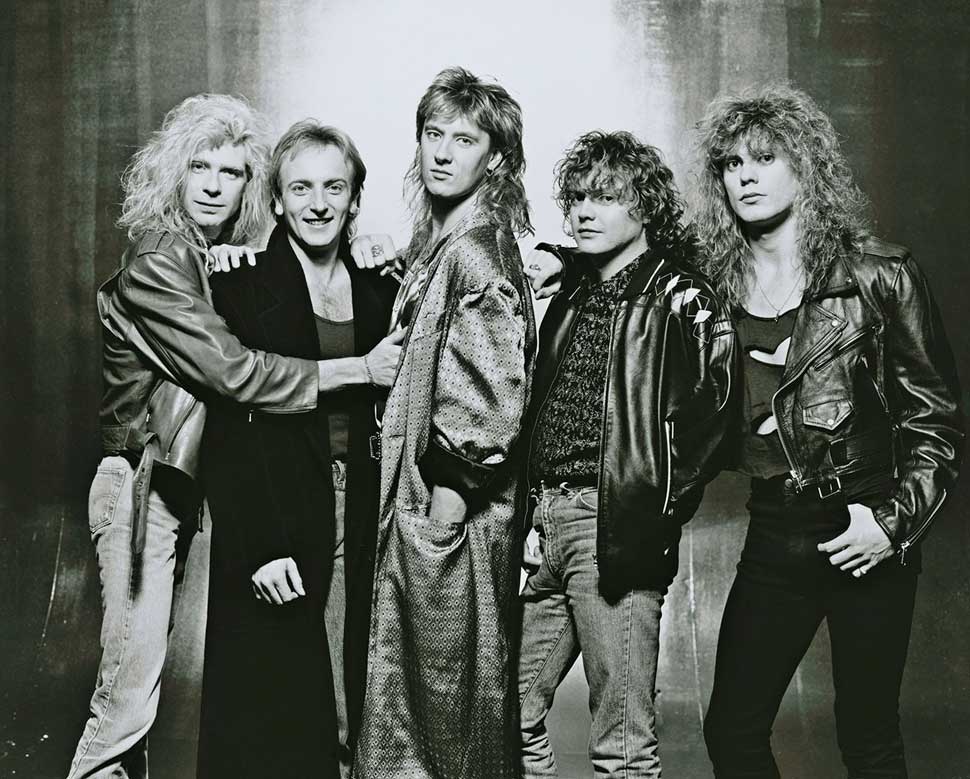
Adrenalize was released on March 31, 1992. In Rolling Stone, JD Considine wrote: “There’s no overriding concept to the album, no sense of the group confronting its demons or wrestling with the problems of the world; instead, what we get is an unending string of energetic, hook-heavy, gosh-we-luv-’em songs about girls. A perfect Def Leppard album, in other words.”
It was also an album completely out of step with what was happening in rock music at the time. Just two months earlier, Nirvana’s Nevermind had topped the US chart. A new age of alternative rock had arrived, led by the Seattle grunge bands – Nirvana, Pearl Jam, Soundgarden, Alice In Chains – and Californian outliers Faith No More and Jane’s Addiction. It was the most seismic change in popular music since punk in the late 70s, with Smells Like Teen Spirit, its revolutionary anthem, ringing out like the last bell for the big-haired stars of 80s rock.
Elliott says now that he was largely oblivious to it all: “When we were making Adrenalize it was still the arse end of the eighties, from a mental point of view. The nineties hadn’t kicked in. We weren’t aware of what Kurt Cobain was doing until the album was out.”
Not so Phil Collen: “With grunge, I saw it coming a mile off. There were so many awful hair-metal bands around. Something had to happen. Nirvana and Pearl Jam were a breath of fresh air.”
In this turbulent time, some stars from the 80s were big enough to ride out the storm. Guns N’ Roses were riding high with Use Your Illusion I and II. Bon Jovi, with their 1992 album Keep The Faith, had what Manic Street Preachers bassist Nicky Wire called “a brilliant reinvention”. And there was still a place for Def Leppard. “People were glad we were still around,” Elliott says. “Adrenalize was number one in America for six weeks. It was number one in around thirty counties. It was massive.”
Just a few days after the album’s release, the new guitarist in Def Leppard was announced: Vivian Campbell, formerly of Dio and Whitesnake. Behind the scenes, the band had already tried out other guitarists, including John Sykes, also ex-Whitesnake, and Adrian Smith, at that time between tenures in Iron Maiden. As Collen explains: “There was no formal audition with John and Adrian, they just came and played with us for a while. It was more about us getting a sense of what they were like as people.” Sykes ended up singing backing vocals on Adrenalize.
“John could sing his ass off,” Elliott says. “And he wrote Still Of The Night for Whitesnake. Adrian I adore, and in the end it worked out well for him because he’s back in Maiden where he belongs. We also tried out a young unknown kid from Birmingham, Huey Lucas. Great player, but his voice wasn’t that strong. Vivian was always the number-one candidate. For us it wasn’t about how well you could play, it was more about how well you can sing. And more importantly, we’ve got to get on with this person.”
On April 20, the new-look Def Leppard performed at the Freddie Mercury Tribute Concert For Aids Awareness at Wembley Stadium, at which the surviving members of Queen, joined by a stellar supporting cast including David Bowie, Robert Plant, Elton John, Guns N’ Roses and Metallica, paid tribute to their late singer. With an audience of 80,000 in the stadium and more than a billion people watching on live TV, it was the perfect set-up for Leppard’s forthcoming world tour.
“The tour was huge,” Elliott says. “It was bigger than Hysteria.” It included a victorious homecoming show at the newly built Don Valley Stadium, where the band played to 50,000 people. The final leg was in North America at the end of that year. “I remember being on our private plane,” the singer says, “flying over Manhattan at two in the morning, having just finished a bunch of sell-out shows, and going: ‘Yeah, about this grunge thing…’”
Adrenalize sold seven million copies worldwide. In the US the singles were not as successful as those from Hysteria, with only Let’s Get Rocked and Have You Ever Needed Someone So Bad making the Top 20. But in the UK they had four big hits.
It was after Adrenalize that Def Leppard struggled. “Everything changed after that,” Collen says. “In the late nineties it went tits-up for a while, but we soldiered on.” Their 1996 album Slang was an alt.rock-influenced volte-face, but their last album of that decade, Euphoria, was a return to Leppard’s classic sound.
For Elliott and Collen, looking back on Adrenalize from a distance there are mixed feelings. Elliott thinks of it as the end of an era, “the last in a trilogy” after Pyromania and Hysteria. What he hears now in Adrenalize is the early roots of Leppard. “Other than White Lightning the music is very mid-seventies glam,” he says.
Collen is more critical: “With Hysteria we felt that we’d created a slightly new rock genre. It was so creative and so left-field. With Adrenalize we were copying that formula.”
What Adrenalize lacked was the shock of the new that Hysteria had: the blockbuster production that Collen describes as “Star Wars for the ears”; the spirit of adventure in songs such as Pour Some Sugar On Me, Rocket and Animal. With Hysteria Def Leppard were breaking new ground; with Adrenalize they were holding ground. In the circumstances, it was more than enough.
They had dug deep to make this album. And the last two songs they wrote for Adrenalize would remain powerfully symbolic: White Lightning the epitaph for the friend they lost, Let’s Get Rocked the anthem with which they moved on.
This feature originally appeared in Classic Rock 247, published in February 2018.
Freelance writer for Classic Rock since 2005, Paul Elliott has worked for leading music titles since 1985, including Sounds, Kerrang!, MOJO and Q. He is the author of several books including the first biography of Guns N’ Roses and the autobiography of bodyguard-to-the-stars Danny Francis. He has written liner notes for classic album reissues by artists such as Def Leppard, Thin Lizzy and Kiss, and currently works as content editor for Total Guitar. He lives in Bath - of which David Coverdale recently said: “How very Roman of you!”

